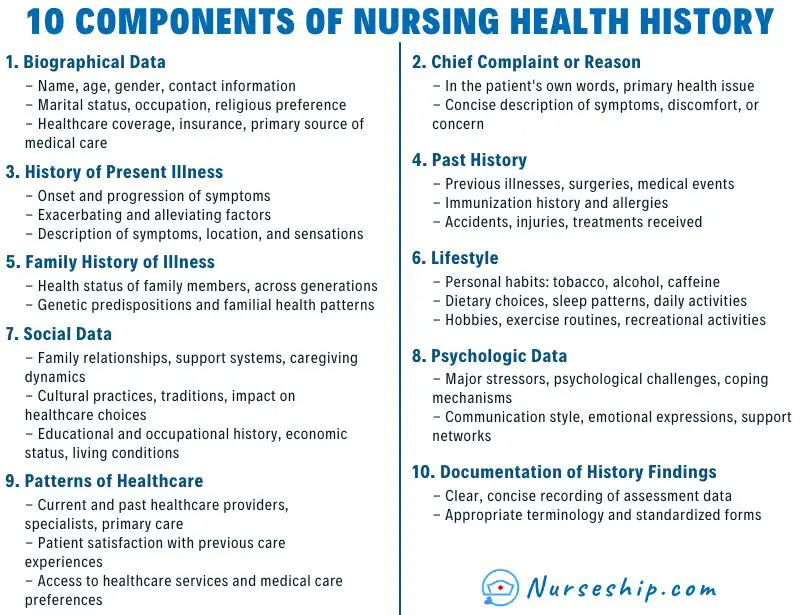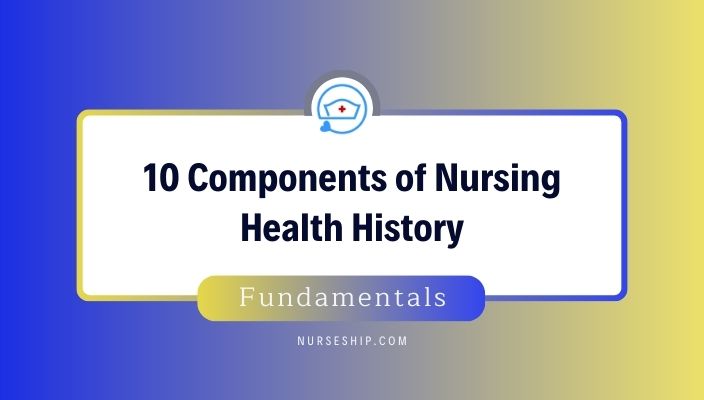Last updated on December 28th, 2023
Performing a comprehensive nursing health history is crucial for effective patient care. This nursing assessment process involves collecting a wide range of information to build a complete picture of the patient’s health and life.
In this article, we will explore the ten components of nursing health history.
Related:
- What Is Nursing Assessment?
- Subjective VS Objective Data In Nursing Assessment: What’s the Difference?
- What Is The Nursing Process? ADPIE 5 Steps Explained!
10 Components of Nursing Health History

1. Biographical Data
Biographical Data: A Snapshot of Identity
- Name, age, gender, and contact information.
- Marital status, occupation, and religious preference.
- Healthcare coverage, insurance, and primary source of medical care.
This component serves as the introduction, providing a canvas on which the patient’s health journey will be painted.
2. Chief Complaint or Reason for Seeking Care
Chief Complaint or Reason for Seeking Care: Unveiling the Purpose
- In the patient’s own words, the primary issue bringing them to healthcare.
- A concise description of symptoms, discomfort, or concern.
The patient’s voice emerges, setting the tone for the entire health history and emphasizing the patient’s perspective.
3. History of Present Illness
History of Present Illness: Tracing the Timeline
- When symptoms began and their progression.
- Factors influencing symptom severity, including exacerbating and alleviating factors.
- Description of the symptoms, their location, and associated sensations.
This component paints a dynamic picture of the patient’s current health challenge, allowing healthcare providers to grasp its nuances.
4. Past History
Past History: A Glimpse into Medical Chronicles
- Previous illnesses, surgeries, and significant medical events.
- Immunization history and allergy details.
- Accidents, injuries, and treatments received.
The patient’s medical journey unfolds, offering insights into their health experiences and potential health risks.
5. Family History of Illness
Family History of Illness: Genetic Signposts
- Health status of family members, spanning generations.
- Genetic predispositions and familial health patterns.
This component establishes connections between the patient’s health and their family’s medical background.
6. Lifestyle
Lifestyle: Patterns of Daily Living
- Personal habits involving substances like tobacco, alcohol, and caffeine.
- Dietary choices, sleep patterns, and daily activities.
- Hobbies, recreational activities, and exercise routines.
By understanding the patient’s lifestyle, healthcare providers gain insight into their overall well-being.
7. Social Data
Social Data: Nurturing Networks
- Family relationships, support systems, and caregiving dynamics.
- Cultural practices, traditions, and their impact on healthcare decisions.
- Educational and occupational history, economic status, and living conditions.
This component contextualizes the patient’s health within their social environment, highlighting influential factors.
8. Psychologic Data
Psychologic Data: Delving into Emotional Landscapes
- Major stressors, psychological challenges, and emotional coping mechanisms.
- Communication style, emotional expressions, and support networks.
Understanding the patient’s emotional well-being enhances the ability to provide empathetic and holistic care.
9. Patterns of Healthcare
Patterns of Healthcare: Tracing Medical Footprints
- Current and past healthcare providers, including specialists and primary care.
- Patient’s satisfaction with previous care experiences.
- Access to healthcare services and preferences for medical care.
This component unveils the patient’s medical journey, guiding the creation of a tailored care plan.
10. Documentation of History Findings
Documentation of History Findings: Crafting the Narrative
- Recording assessment data clearly and concisely.
- Utilizing appropriate terminology and standardized forms.
See Also:
- What is Critical Thinking in Nursing? (Explained W/ Examples)
- 15 Attitudes of Critical Thinking in Nursing (Explained W/ Examples)
- Nursing Concept Map (FREE Template)
- Clinical Reasoning In Nursing (Explained W/ Example)
- 8 Stages Of The Clinical Reasoning Cycle
- How To Improve Critical Thinking Skills In Nursing? 24 Strategies With Examples
Conclusion
A nursing health history is like a work of art, woven from the threads of a patient’s life. These ten components blend together to form a complete picture of the patient’s health and needs.
By skillfully gathering health history nurses can offer personalized, patient-centered care, nurturing healing and compassion.
Recommended Readings
Potter, P.A., Perry, A.G., Stockert, P. and Hall, A. (2013) Fundamentals of Nursing
Kozier & Erb’s Fundamentals of Nursing: Concepts, Process and Practice, 11th edition



Comments are closed.